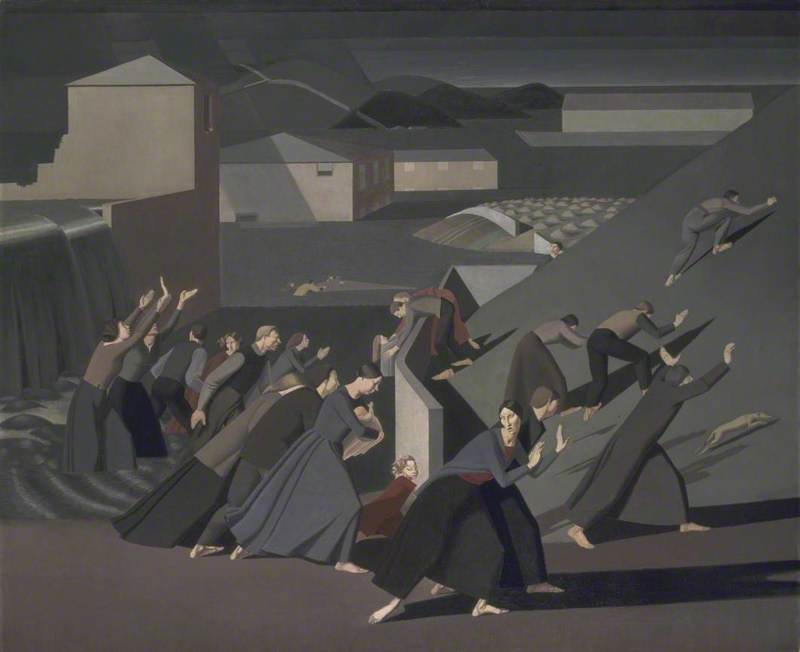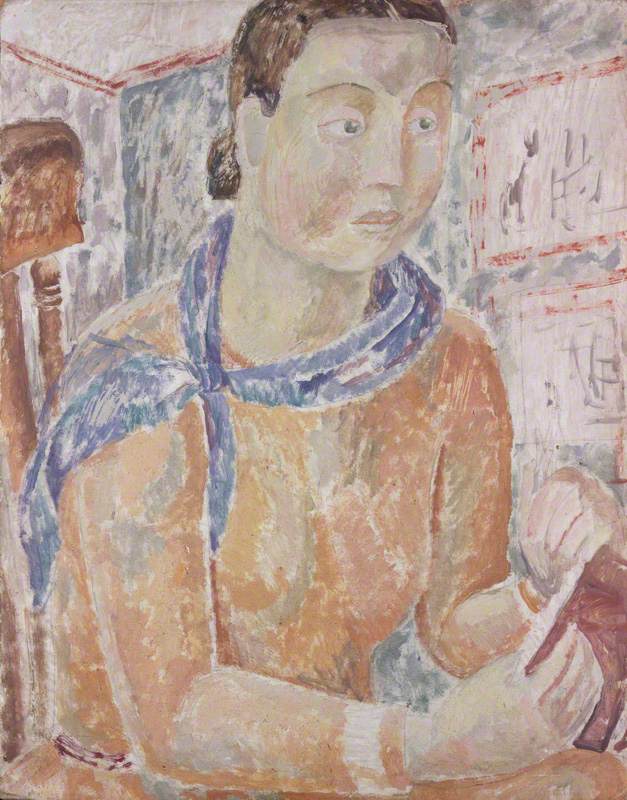Curated by undergraduate students on the University of St Andrews, School of Art History, AH4196: English Art & Modernism module (2022), this exhibition explores the development of English Art (1900-1960).
It opens with a challenge to tradition from painter Harold Gilman, before exploring gender, the urban vs rural, abstraction vs realism, war, traditions in English art, and the aesthetic development of modernism.
Curators: Izzy Baradaran, Catherine Barrie, Elena Bowden, Kate Capstick-Dale, Esther David-Deleplanque, Trinny Duncan, Bella Flame, Emma Haddow, Katriona Hannah, Mia Hart, Helen Jorgensen, Sarah Knight, Natasha Long, Mhairi McCracken, Ellie McKay, Isabel Simpson, Sophie Turner, and Emma Volini.
Dr Billy Rough, December 2022.
-
Nude at a Window
Nude at a Window c.1912Shifting away from a ‘Venus’, Gilman’s painting encompasses a risqué subject matter of a modern, unidealized, female nude. The implied spontaneity of the model’s pose in combination with Gilman’s loose brushwork and unnaturalistic colour palette creates an air of relaxation and frank sexual freedom. This portrait reflects Gilman’s awareness of Suffrage movements and indeed the emergence of the 'New Woman' in British society as this erotically charged image celebrates a woman as liberated, sexually free and ultimately at ease in her own nakedness. Influenced by the 1910 ‘Manet and the Post-Impressionist’ exhibition, Gilman challenged academic tradition as he depicted a modern reality omitted from classical art.
Emma H.
Harold Gilman (1876–1919)
Oil on canvas
H 61 x W 50.8 cm
Tate
-
Ennui
Ennui c.1914A melancholic scene of a couple in a gloomy domestic space, Ennui appears incredibly mundane, depicting a seemingly insignificant moment. Sickert’s realism portrays a natural scene, evading all tendencies towards abstraction. Meaning ‘boredom’, ennui was seen during the early 20th century as a symptom of degeneration, a pathological disease caused by modern anxieties. Bleak colours create a sombre atmosphere whilst the birds confined in the bell jar mirror the woman who seems equally trapped within her surroundings. Ennui provides a profound observation of the human condition within a dramatically changing world and showcases Sickert’s commitment to depicting authentic moments.
Emma V. & Katriona
Walter Richard Sickert (1860–1942)
Oil on canvas
H 152.4 x W 112.4 cm
Tate
-
Abstract Painting
Abstract Painting c.1914One of only four fully non-representational paintings Abstract Painting was a brief break in Bell’s otherwise expressionist style. Illustrating her engagement with European modes of abstraction, the painting plays with materiality and flatness, with a deliberate lack of finish through the visible brushstrokes. Inspired by post-impressionism, the painting is also informed by Bell’s work with the Omega Group; her textile designs show similarly bold patterning. This brief moment in abstraction did not last and Bell soon returned to expressive figuration, although the balancing of proportion and professed materiality from her abstract pieces continued to instruct her later work.
Esther, Mhairi & Trinny
Vanessa Bell (1879–1961)
Oil on canvas
H 44.1 x W 38.7 cm
Tate
-
Abstract Composition
Abstract Composition c.1915Dismorr’s Abstract Composition rejects figuration and embraces shape and colour as its primary means of expression. Dismorr looks towards Vorticism and abstraction as a way to find freedom from creating art under a gendered lens in fin-de-siècle England. Dismorr’s abstraction arguably comes the closest a Vorticist piece gets to pure abstraction, however, the composition’s use of colour and space can allude to a broken cityscape. The geometric shapes represent the Vorticist machine aesthetic; an aesthetic which sought to embrace the chaos of modernity. Dismorr puts herself in communion with her contemporaries by drawing on Kandinsky’s colour theory, further allowing her work to be read outside of gendered terms.
Isabel S. & Helen
Jessica Dismorr (1885–1939)
Oil on wood
H 41.3 x W 50.8 cm
Tate
-
The Mule Track
The Mule Track 1918Here, Nash depicts the devastating effects of WWI on the landscape; a distorted scene of scarred earth and the trees he so loved now symbolizing the dying and dead. Nash’s war saw his relationship with Nature visibly change, as his motivation became the dissemination of the disorienting truth of a collective experience of war, witnessed here through exacerbated tensions, between man and Nature and feelings of static and movement and an urgent and disjointed rhythm. This animated landscape visualizes Nash’s understanding of the suffering of Nature; his connection with the landscape was not entirely severed, but his practice fundamentally shifted as he was pushed into a new category of Modernism, of men tortured by war.
Sarah
Paul Nash (1889–1946)
Oil on canvas
H 60.9 x W 91.4 cm
IWM (Imperial War Museums)
-
The Deluge
The Deluge 1920Knights depicts a frenzied biblical scene in which God imposes a great flood upon humankind. Chaos reigns, as figures desperately clamber, in vain hope, to safety. Here is a disorganised community, tethered loosely by dull terracotta hues. Beyond flashes of muted colour, Knights favours a sombre palette. Indeed, throughout The Deluge, the artist interrogates the consequences of WWI; Vorticist lines of angular pasture pollute the ‘rural condition’, while the foreground Greek choral figure embodies the uncertainty of the immediate post-war years, her feet drawn towards alternate directions. Merging the ancient and the avant-garde, The Deluge is an emblem of post-war anxiety and subsequent ‘return to order’ in interwar modernism.
Elena
Winifred Knights (1899–1947)
Oil on canvas
H 152.9 x W 183.5 cm
Tate
-
Mother and Child
Mother and Child 1934At the forefront of modernist sculpture in the middle of the 20th century, Hepworth’s early works also drew on the narrative of maternity as well as on her personal experiences. Here, Hepworth’s figurative and abstract aesthetic helps to suggest the complexity of motherhood to the viewer. The arbitrary hole in the middle suggests, for example, the womb from which the child, now placed on the Mother’s knee, came from. Hepworth’s work exemplifies the tension of welcoming motherhood in a diversifying modernist movement. A leading woman in the male dominated modernist movement, Hepworth redefined gender stereotypes and pioneered new techniques that were utilized throughout her career.
Bella & Kate
Barbara Hepworth (1903–1975)
Cumberland alabaster on marble base
H 23 x W 45.5 x D 18.9 cm
Tate
-
Self Portrait with Patricia Preece
Self Portrait with Patricia Preece 1937Spencer’s portrait places itself firmly in the canon of English modern art. With a subject matter that recalls Sickert and an aestheticism that predicted the style of Francis Bacon and Lucien Freud,. Painted during the interim period of the WWI and WWII, it is clear Spencer is painting an England that is awkwardly poised between modernity and the safety of tradition, though this is not to call Spencer’s piece a call to return to what once was. The Victorian iron bed frames and twee English wallpaper, as well as the bodies of Spencer and Preece are bleakly treated with a beige tea-stained, dated wash. Spencer suggests the reality of a dying English idealism that had been nestled in the English psyche.
Catherine
Stanley Spencer (1891–1959)
Oil on canvas
H 61 x W 91.2 cm
The Fitzwilliam Museum
 © the estate of Stanley Spencer. All rights reserved / Bridgeman Images. Image credit: The Fitzwilliam Museum
© the estate of Stanley Spencer. All rights reserved / Bridgeman Images. Image credit: The Fitzwilliam Museum
-
Winter Walk, No. 2
Winter Walk, No. 2 1948Winter Walk, No.2 is part of a series of landscapes painted near Hitchens’ Sussex home. After his London studio was bombed in 1940, Hitchens moved to the Sussex countryside. It is tempting to place Hitchens within the English landscape tradition and read his paintings for their topographical value, however, the visible brush marks and unnatural colours expresses his personal response to the landscape rather than its geography. Multiple viewpoints within the painting’s long horizontal composition allows our eye to roam, replicating our subjective interaction with nature. Hitchens’ series push the boundaries of representation, yet they never achieve total abstraction as he always offers viewers something concrete to respond to.
Sophie
Ivon Hitchens (1893–1979)
Oil on canvas
H 42 x W 110 cm
Government Art Collection
-
Head VI
Head VI 1949A characteristic of Bacon's work is that they shock the viewer and Head VI is no different. This painting is one of six in a series of 'Heads' that he painted in the late 1940s, all depicting isolated figures in darkened rooms. Debate continues on the significance and meaning of his screaming figures but, whatever the interpretation, the importance of them to Bacon’s oeuvre cannot be denied. The figure is based on Velazquez's portrait of Pope Innocent X demonstrating that Bacon was influenced by the Old Masters, despite being considered a "modern" artist. However, we see how Bacon manipulates his source material, changing it from an image of authority and power to one of despair and anguish.
Ellie & Mia
Francis Bacon (1909–1992)
Oil on canvas
H 93.2 x W 76.5 cm
Arts Council Collection, Southbank Centre
-
A Bigger Splash
A Bigger Splash 1967A Bigger Splash was painted three years after Hockney moved from the UK to Los Angeles, and illustrates Hockney’s unique perspective on American culture. Here is a celebration of the L.A. lifestyle, evident in the idealized landscape of a quintessential backyard pool. This painting features a bright colour palette, simplified forms, and smooth brushwork; all aesthetic characteristics of Pop Art. Contrasting the timeless tradition of English landscape painting, Hockney portrays a more fleeting moment, the splash itself, which signifies the playful energy of L.A. The title too would humorously symbolise Hockney’s growing success in America. We’ve come a long way from the domestic and urban realism of Walter Sickert.
Izzy & Natasha
David Hockney (b.1937)
Acrylic on canvas
H 242.5 x W 243.9 cm
Tate
Explore artists in this Curation
View all 11-
 Winifred Knights (1899–1947)
Winifred Knights (1899–1947) -
 Jessica Dismorr (1885–1939)
Jessica Dismorr (1885–1939) -
 Ivon Hitchens (1893–1979)
Ivon Hitchens (1893–1979) -
 Vanessa Bell (1879–1961)
Vanessa Bell (1879–1961) -
 Harold Gilman (1876–1919)
Harold Gilman (1876–1919) -
 Walter Richard Sickert (1860–1942)
Walter Richard Sickert (1860–1942) -
 Paul Nash (1889–1946)
Paul Nash (1889–1946) -
 Barbara Hepworth (1903–1975)
Barbara Hepworth (1903–1975) -
 Stanley Spencer (1891–1959)
Stanley Spencer (1891–1959) -
 Francis Bacon (1909–1992)
Francis Bacon (1909–1992) - View all 11







